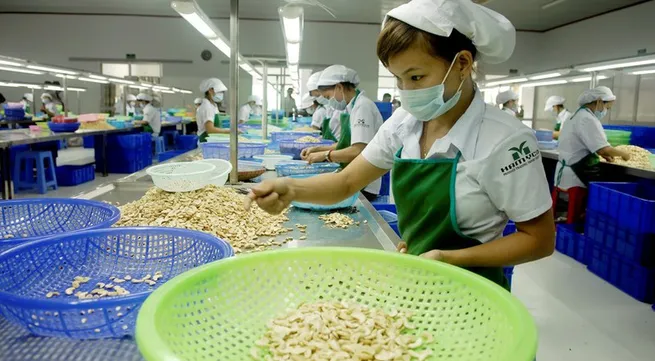Exports expected to face risks until next year

Next week will see the official announcement of figures of Vietnam’s exports and imports for 2022, but the government has been expecting that for 2022, total export turnover will be 368 billion USD – up 9.46% against 2021, far higher than the target of 329.9 billion USD set early this year.
Meanwhile, total import turnover will be around 367 billion USD, higher than the target of 330.9 billion USD set early this year. All are thanks to consumers’ high spending, and tax reduction and removal under free trade agreement commitments.
This will mean a trade surplus of 1 billion USD for this year, quite the contrary to the trade deficit of 1 billion USD expected early this year.
The Ministry of Industry and Trade (MoIT) has reported that the economy’s total 11-month goods export-import turnover is estimated to be 673.82 billion USD – up 11.8% year-on-year. Of which export turnover stood at 342.21 billion USD – up 13.4%, and import turnover sat at 331.61 billion USD – up 10.1%. There has thus been a trade surplus of 10.6 billion USD.
Vietnam has consecutively recorded a trade surplus over many months, at 809 million USD in Q1, 2.53 billion USD in four months, 516 million USD in five months, 1.28 billion USD in six months, 764 million USD in seven months, 5.49 billion USD in eight months, 5.7 billion USD in nine months, and 9.4 billion USD in 10 months.
In the first 11 months of this year, up to 35 items had an export turnover of more than 1 billion USD – accounting for 93.7% of the country’s total export turnover. This includes eight items with export turnover of over 10 billion USD – responsible for 70.1% of the total.
Industrial items with big export value include mobile phones and spare parts (55.37 billion USD – up 6.6% year-on-year); computers, electronics and spare parts (50.52 billion USD – up 11%), machinery and equipment (41.97 billion USD, up 23.3% year-on-year); garments and textiles (34.53 billion USD, 18.5%); and footwear (22.1 billion USD, 49.9%), wood and wooden products (14.6 billion USD, 9%), among many others.
The government has also set a goal that Vietnam’s total goods export-import turnover for next year will be as much as 795 billion USD, up about 8% compared to that of this year. Of which export turnover will be 398 billion USD – up over 8% year-on-year. The trade surplus will stand at around 1 billion USD.
To reach it, the government has directed the MoIT and its authorised agencies to continue to study and apply suitable solutions to expand markets and take advantage of the benefits brought about by the free trade agreements having already entered into force.
However, many experts say that it will be difficult for the 2023 goals to be realised due to various risks lingering and affecting Vietnam’s trade. In fact, export and import turnover have been showing signals of reduction.
Figures from the General Statistics Office’s show that monthly trade values during September-November declined remarkably to about 29.5 billion USD of exports and over 28 billion USD of imports, from 31.3 billion USD and 31 billion USD, respectively, in the March-August period. Notably, year’s end often sees a rise in exports thanks to global demand rising.
The World Bank has said that Vietnam’s two drivers of economic growth - exports and domestic demand - are moderating.
“Softer external demand has weighed on Vietnam’s exports. The post-COVID consumption rebound also appears to be fading and tighter domestic financial conditions and rising inflation could affect domestic demand going forward,” the bank said.
According to Nguyen Cam Trang, deputy director of the Agency of Foreign Trade under the MoIT, Vietnam’s trade activities will face many difficulties and challenges until next year. She said that goods supply disruptions and high input material prices for production make many major economies in the world, including the US and the European Union, face challenges and the risk of falling into recession.
“High inflation in markets, especially the main export markets of Vietnam, also reduces the demand for consumer goods,” Trang said. “Meanwhile, consumer goods are essential export products of Vietnam, such as textiles, footwear, and furniture. Therefore, those would also directly affect the export growth trend of these products” Trang said.
According to VNDirect, Vietnam’s GDP growth peaked in the third quarter of 2022 and will slow down in the fourth quarter of 2022 due to weak external demand.
The reason is that Vietnam’s major trading partners such as the US and the European Union have experienced slow economic growth, which may reduce the export outlook of Vietnam. At the same time, rising inflation could affect the recovery of domestic consumption. Rising interest rates increase costs and affect business expansion plans, also a negative factor for Vietnam’s economy.
According to the World Bank, global growth is expected to slump from 5.7% in 2021 to 2.9% in 2022 - significantly lower than the 4.1% that was anticipated in January.
“It is expected to hover around that pace over 2023-2024, as the war in Ukraine disrupts activity, investment, and trade in the near term, pent-up demand fades, and fiscal and monetary policy accommodation is withdrawn,” said the World Bank in a press release. “Growth in advanced economies is projected to sharply decelerate from 5.1% in 2021 to 2.6% in 2022 - 1.2 percentage points below projections in January. Growth is expected to further moderate to 2.2% in 2023, largely reflecting the further unwinding of the fiscal and monetary policy support provided during the pandemic.”
Risks include growth slowdown or stagflation in large export markets, further commodity price shocks, the continued disruption of global supply chains, or the emergence of new COVID-19 variants. Domestic challenges include continued labour shortages, the risk of higher inflation, and heightened financial sector risks, the World Bank warned.
The MoIT has also been ordered by the government to direct Vietnam’s trade offices overseas to seek more information from the markets where they are located so as to timely provide consultancy for the government and the prime minister on how to boost exports to these markets.
The government has promulgated a decision approving an action programme to implement the country’s Commodity Import-Export Strategy by 2030.
The strategy aims to achieve sustainable import and export towards a balanced and harmonious structure, promote competitive advantages, comparative advantages, develop the brands of Vietnamese goods, open up new markets and potential fields and raise the country’s position in the global supply and value chains.
The main tasks include (i) expand production and sustainable supply for export; (ii) develop import and export markets, ensure long-term sustainable growth; perfect regulations, strengthen state management in export activities in order to facilitate trade, prevent trade frauds and ensure fair trade; (iv) mobilise and efficiently utilise resources for export development; (v) manage and control import to meet the demand for domestic production towards a healthy and reasonable trade balance; (vi) raise the role of associations and nucleus enterprises to nurture large-scale export value chains.
The Ministry of Agriculture and Rural Development is responsible for implementing the plan on restructuring the agricultural sector in combination with digital transformation, digital economic development, green production, development of tourism, gastronomy, and agricultural and aquacultural exports.
The Ministry of Industry and Trade is in charge of restructuring industries and accelerating digital transformation in the processing and manufacturing sector in order to generate new impetus for export and production.
The Ministry of Science and Technology assumes the prime responsibility for and coordination with related ministries and branches to perfect the policy system for scientific and technological activities and innovation, encouraging projects and research on new materials, manufacturing and exporting environmentally friendly and high innovative products.
Under the strategy, Vietnam’s exports are expected to expand by 8-9% in the 2021-2025, period and 5-6% in the 2026-2030 period.





